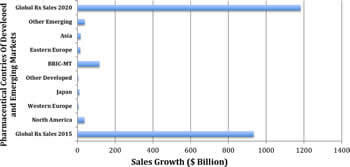Branded generics are off-patent drugs that are marketed under a brand name rather than the generic name of their active ingredient. These medications are typically produced by established pharmaceutical companies and carry the reputation and quality assurance associated with well-known brands. Unlike traditional generics, which are often perceived as lower-quality alternatives, branded generics aim to offer the best of both worlds: the affordability of generics and the trust associated with brand-name drugs.
The Rise of Branded Generics
The concept of branded generics has gained significant momentum in recent years, particularly in emerging markets. According to a report by McKinsey & Company, branded generics accounted for approximately 25% of the global pharmaceutical market in 2020, with projections indicating continued growth. This trend is driven by several factors, including increasing healthcare costs, patent expirations of blockbuster drugs, and a growing demand for affordable yet reliable medications.
The Business Case for Branded Generics
Profit Potential for Drugmakers
For pharmaceutical companies, branded generics represent a lucrative opportunity to diversify their product portfolios and tap into new revenue streams. By leveraging their existing brand equity and manufacturing capabilities, drugmakers can produce these medications at a lower cost while still commanding a premium over traditional generics.
“Branded generics allow pharmaceutical companies to maintain a strong market presence even after patent expiration, effectively extending the lifecycle of their products and preserving brand loyalty.” – Dr. Sarah Thompson, Pharmaceutical Industry Analyst
Market Expansion Strategies
Branded generics offer drugmakers a strategic avenue to penetrate emerging markets where brand recognition plays a crucial role in consumer decision-making. By introducing familiar brand names at more accessible price points, companies can capture a larger market share and establish a strong foothold in these rapidly growing economies.
Mitigating Patent Cliff Risks
The pharmaceutical industry has long grappled with the challenge of patent cliffs, where the expiration of patents on blockbuster drugs leads to a sharp decline in revenues. Branded generics provide a cushion against this phenomenon, allowing companies to maintain a steady income stream even as their flagship products face generic competition.
Benefits for Patients
Affordability Without Compromise
One of the primary advantages of branded generics for patients is the ability to access high-quality medications at a more affordable price point. While not as cheap as traditional generics, branded generics typically cost 20-30% less than their brand-name counterparts, making them an attractive option for cost-conscious consumers.
Enhanced Trust and Peace of Mind
Many patients express concerns about the quality and efficacy of traditional generic drugs, often preferring brand-name medications despite the higher cost. Branded generics bridge this gap by offering the reassurance of a trusted brand name while still providing significant cost savings.
Improved Medication Adherence
Studies have shown that patients are more likely to adhere to their prescribed treatment regimens when using branded generics compared to traditional generics. This improved adherence can lead to better health outcomes and reduced healthcare costs in the long run.
Regulatory Landscape and Quality Assurance
FDA Approval Process
In the United States, branded generics undergo the same rigorous approval process as traditional generics. The FDA requires these medications to demonstrate bioequivalence to the reference listed drug (RLD) and meet strict quality standards. This ensures that patients receive medications that are therapeutically equivalent to their brand-name counterparts.
Quality Control Measures
Pharmaceutical companies producing branded generics often implement additional quality control measures to maintain their brand reputation. These may include more frequent inspections, advanced manufacturing technologies, and stringent testing protocols.
Global Regulatory Harmonization
As the market for branded generics expands globally, efforts are underway to harmonize regulatory standards across different countries. Initiatives like the International Council for Harmonisation of Technical Requirements for Pharmaceuticals for Human Use (ICH) aim to streamline the approval process and ensure consistent quality standards worldwide.
Market Dynamics and Competition
Impact on Traditional Generic Manufacturers
The rise of branded generics has created new challenges for traditional generic drug manufacturers. These companies must now compete not only on price but also on brand recognition and perceived quality. Some generic manufacturers have responded by developing their own branded generic lines or partnering with established pharmaceutical companies.
Pricing Strategies and Market Segmentation
Branded generics occupy a unique position in the pharmaceutical market, allowing for more nuanced pricing strategies. Companies can segment their offerings based on factors such as brand strength, therapeutic area, and target market, optimizing their revenue potential while still providing value to patients.
Consolidation and Strategic Partnerships
The branded generics market has seen a wave of consolidation and strategic partnerships as companies seek to strengthen their positions. Mergers and acquisitions, as well as licensing agreements between brand-name and generic manufacturers, have become increasingly common.
Challenges and Controversies
Balancing Innovation and Affordability
Critics argue that the focus on branded generics may divert resources from research and development of new drugs. Striking the right balance between investing in innovation and providing affordable medications remains a key challenge for the industry.
Potential for Market Manipulation
Some concerns have been raised about the potential for pharmaceutical companies to use branded generics as a means of extending their market exclusivity and delaying true generic competition. Regulatory bodies must remain vigilant to ensure fair market practices.
Education and Awareness
Many patients and healthcare providers are still unfamiliar with the concept of branded generics. Educating stakeholders about the benefits and limitations of these medications is crucial for their widespread adoption and appropriate use.
Future Outlook and Trends
Technological Advancements
Emerging technologies such as artificial intelligence and advanced analytics are expected to play a significant role in the development and manufacturing of branded generics. These innovations could lead to more efficient production processes and improved quality control measures.
Personalized Medicine and Branded Generics
As the field of personalized medicine continues to evolve, there may be opportunities to develop branded generic versions of targeted therapies. This could potentially make precision medicine more accessible to a broader patient population.
Sustainability and Environmental Considerations
With increasing focus on environmental sustainability, pharmaceutical companies producing branded generics may need to adopt more eco-friendly manufacturing practices and packaging solutions to meet consumer expectations and regulatory requirements.
Case Studies: Success Stories in Branded Generics
Teva Pharmaceuticals: A Global Leader
Teva Pharmaceuticals has successfully leveraged its expertise in both brand-name and generic drugs to become a major player in the branded generics market. The company’s diverse portfolio and strong presence in emerging markets have contributed to its success in this segment.
Sun Pharma’s Strategic Acquisitions
Indian pharmaceutical giant Sun Pharma has expanded its branded generics business through strategic acquisitions, including the purchase of Ranbaxy Laboratories. This move has significantly strengthened Sun Pharma’s position in the global branded generics market.
Novartis Sandoz: Embracing a Dual Strategy
Novartis, through its Sandoz division, has adopted a dual strategy of producing both traditional generics and branded generics. This approach has allowed the company to cater to different market segments and maintain a strong competitive position.
The Role of Branded Generics in Healthcare Systems
Cost Savings for Healthcare Providers
Healthcare systems and insurance providers can benefit from the adoption of branded generics by reducing overall drug expenditures while still providing patients with trusted medication options. This can lead to more sustainable healthcare financing and improved access to treatments.
Formulary Decisions and Reimbursement Policies
As branded generics gain prominence, healthcare payers and formulary committees must reevaluate their decision-making processes. Factors such as cost-effectiveness, patient preferences, and clinical outcomes will play crucial roles in determining the placement of branded generics within formularies.
Impact on Prescribing Patterns
The availability of branded generics may influence prescribing patterns among healthcare providers. Physicians may be more inclined to prescribe these medications, particularly for patients who express concerns about traditional generics or have experienced issues with medication adherence.
Global Market Variations
Emerging Markets: Driving Growth
Emerging markets, particularly in Asia and Latin America, have been at the forefront of the branded generics revolution. These regions often have less stringent patent protection and a higher emphasis on brand recognition, creating fertile ground for branded generic products.
Developed Markets: A Different Landscape
In developed markets like the United States and Europe, the adoption of branded generics has been slower due to well-established generic drug markets and different regulatory environments. However, there is growing interest in these products as healthcare systems seek to balance cost containment with quality assurance.
Regulatory Differences and Market Access
The regulatory landscape for branded generics varies significantly across different countries. Understanding and navigating these differences is crucial for pharmaceutical companies looking to expand their branded generics portfolios globally.
The Patient Perspective
Consumer Perceptions and Preferences
Understanding patient perceptions and preferences regarding branded generics is crucial for their successful adoption. Surveys have shown that many patients are open to using branded generics when provided with adequate information about their quality and cost-effectiveness.
Patient Education Initiatives
Pharmaceutical companies and healthcare providers are increasingly focusing on patient education initiatives to raise awareness about branded generics. These efforts aim to empower patients to make informed decisions about their medication options.
Addressing Concerns and Misconceptions
Common concerns about generic medications, such as efficacy and side effects, must be addressed to build trust in branded generics. Clear communication about the regulatory standards and quality control measures in place can help alleviate these concerns.
Innovation in Branded Generics
Value-Added Formulations
Some pharmaceutical companies are differentiating their branded generics by developing value-added formulations. These may include improved delivery methods, fixed-dose combinations, or extended-release versions of existing medications.
Digital Health Integration
The integration of digital health technologies with branded generic products offers new opportunities for patient engagement and medication adherence. Smart packaging, mobile apps, and remote monitoring tools can enhance the overall patient experience.
Sustainable Manufacturing Practices
As environmental concerns become increasingly important to consumers, pharmaceutical companies are exploring sustainable manufacturing practices for their branded generic products. This includes reducing waste, minimizing energy consumption, and using eco-friendly packaging materials.
Economic Impact of Branded Generics
Job Creation and Economic Growth
The branded generics sector has the potential to create significant employment opportunities, particularly in emerging markets. Manufacturing facilities, research and development centers, and distribution networks all contribute to economic growth in the regions where these products are produced.
Investment in Local Manufacturing
Many countries are encouraging the local production of branded generics as a means of reducing healthcare costs and boosting domestic pharmaceutical industries. This has led to increased investment in manufacturing facilities and technology transfer initiatives.
Trade Implications and Export Opportunities
The global nature of the branded generics market has important implications for international trade. Countries with strong branded generics industries may find new export opportunities, while others may need to reevaluate their pharmaceutical import policies.
Ethical Considerations
Access to Essential Medicines
Branded generics have the potential to improve access to essential medicines in underserved populations. However, careful consideration must be given to pricing strategies to ensure that these products remain affordable for those who need them most.
Transparency in Marketing and Promotion
As the line between brand-name and generic drugs becomes increasingly blurred, there is a need for greater transparency in the marketing and promotion of branded generics. Clear communication about the nature of these products is essential to maintain patient trust.
Balancing Profit and Social Responsibility
Pharmaceutical companies engaged in the branded generics market must navigate the delicate balance between profitability and social responsibility. Ensuring fair pricing and equitable access to medications should be key considerations in corporate strategies.
Key Takeaways
- Branded generics offer a middle ground between expensive brand-name drugs and traditional generics, providing affordability without compromising on quality and trust.
- For drugmakers, branded generics represent a lucrative opportunity to diversify product portfolios, expand into new markets, and mitigate patent cliff risks.
- Patients benefit from increased affordability, enhanced trust, and potentially improved medication adherence with branded generics.
- The regulatory landscape for branded generics is evolving, with efforts to harmonize standards globally while ensuring quality and safety.
- The rise of branded generics is reshaping market dynamics, leading to consolidation, strategic partnerships, and new competitive challenges.
- Future trends in branded generics include technological advancements, personalized medicine applications, and a focus on sustainability.
- Successful adoption of branded generics requires addressing challenges such as balancing innovation with affordability, market education, and navigating global regulatory differences.
FAQs
- Q: Are branded generics as effective as brand-name drugs?
A: Yes, branded generics are required to demonstrate bioequivalence to the reference listed drug and must meet the same quality standards as brand-name medications. They are considered therapeutically equivalent by regulatory authorities. - Q: How much cheaper are branded generics compared to brand-name drugs?
A: Branded generics typically cost 20-30% less than their brand-name counterparts, offering significant savings while still providing the reassurance of a trusted brand name. - Q: Can branded generics help improve medication adherence?
A: Studies have shown that patients are more likely to adhere to their prescribed treatment regimens when using branded generics compared to traditional generics, potentially leading to better health outcomes. - Q: How are branded generics different from authorized generics?
A: Authorized generics are identical to the brand-name drug and are produced by the same manufacturer, while branded generics are produced by different companies and may have slight differences in inactive ingredients or appearance. - Q: Will the focus on branded generics slow down innovation in the pharmaceutical industry?
A: While there are concerns about potential impacts on innovation, many argue that branded generics can actually support innovation by providing additional revenue streams for pharmaceutical companies to invest in research and development.























